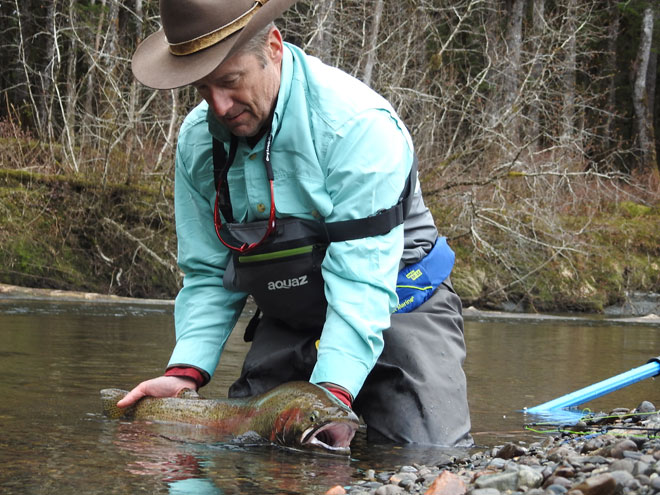
Steelhead fishing on the Situk River
Blog by Gary Lewis
Photos by Gary Lewis & Trey Scharp
Our drift boats were staged at the bridge, waiting.
We were hungry for steelhead. Trey, a 40-something from Wyoming, his dad, Vernon Scharp, my dad, Don, my brother-in-law Shannon Winters, and our friend Gary Davis shoved oars into oar-locks and threw our tackle bags into bow and stern.
Vernon and I had planned this trip on a whim. And now we were at the Glacier Bear Lodge in a town called Yakutat where the rain had stopped and the snow had melted and we found ourselves in a unique circumstance where almost everyone in the lodge was there for one thing. Steelhead.
Pete Eades at the Glacier Bear Lodge had told me there would be no guides available at the end of April.
Pro-tip: Fish Alaska’s favorite fishing lodges to visit
“We do have drift boats for you,” he said. “And we can arrange the shuttles.” That was good enough for us.
Sixteen miles long, the Situk River is unlike any other steelhead river I’ve fished. The lower 14 miles are floatable from the Nine Mile Bridge down almost to the ocean and while that is not so unremarkable, the river is choked with wood. Alders stacked like toothpicks, cedars, hemlocks and spruces, swept down on giant floods bounded nearly every run. Large log jams and root wads are both barriers and habitat. Huge trees lay on their sides with limbs bare and curled, like rib cages of long-dead dinosaurs.
My friend Josiah Darr, a steelheader and a scribe greeted me in the bar to say he was fishing the river these last two weeks of April.
“The shape of this river is what gets me,” he said. “It’s not shaped like a steelhead river.”
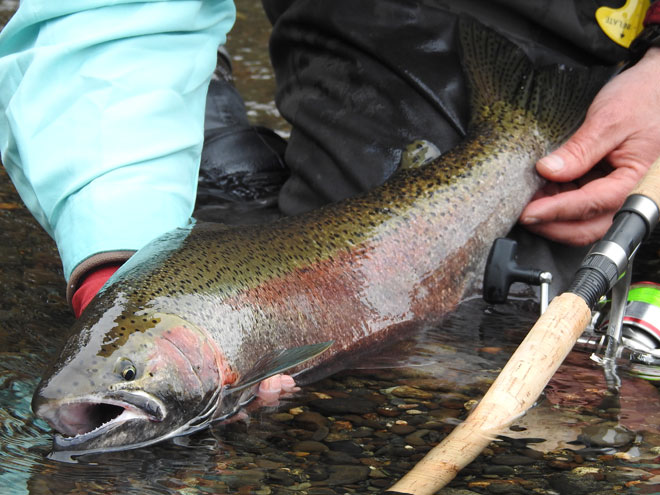
Here at the top of the float, the runs were narrow and the water skinny, the aluminum skins of the drift boats scraped gravel as we slid from run to run, getting the feel of the boats.
Shannon and I traded places at the oars, pointing the bow at a new obstacle at every turn, pulling away from it.
“There.” A steelhead streaked from the tailout, up under a cutbank.
The Situk drains a gentle plain of muskeg and trackless forest, as well as a lake fed by melting snows. Salmon runs fill the river from June through October and steelhead filter in beginning in the fall and in a larger spring run. In Yakutat, from March through April, the buzz is about chrome bullets fresh from the salt and rainbow-splashed, deep-bodied wild fish, some of the biggest in the world.
The fish we saw averaged ten pounds, but now and then we surprised one that would go 16 pounds. We saw their shapes at the end of the runs where they staged over gravel spawning beds. We saw them also beneath the log jams.
Like any good steelhead river, there was lots of gravel, but there were no large boulders. Trees were in every turn of the river, downed timber framed each run.
With polarized glasses, we stood at the oars and peered along current seam lines and beneath cut banks. The flick of a fin might reveal a holding lie, a blue-black back, the shine of chrome beneath a lateral line. Parts of steelhead resolve into whole fish.
After a mile of drift, we fished harder. I took the oars and Shannon cast a micro-jig and float. When the float streaked sideways, he set the hook.
Shannon fought the fish in close after a five-minute battle and then turned it loose in the soft water. As soon as it was gone, I fired a cast into the same run, hooked one and lost it. So many times in my life I have found snappy fish with other snappy fish. I don’t know if it is their competitive nature that kicks in or what, but if one steelhead bites, another may bite from the same pod of fish.
Everywhere, rainbow-striped shadows darted through grasping roots and submerged branches, spooky in the clear water. It was a portent of things to come. Over the next two days the water would drop and the fish would get spookier.
Where the river bent hard left, I had Shannon hold back while I fired a spinner into deep water along a log. Sink. Sink. Sink.
I turned the handle of the reel, felt the slow thump of the blade in the soft rod tip, felt it load up. I set the hook into a chrome bright ten-pounder that thrashed three feet above the surface in a horizontal tantrum and crashed back in a spray of foam. Five minutes later, I cradled it in shallow water.
Each steelhead is like a miracle, a gift out of time, a prehistoric primal beast. And each one we valued more than the last.
FROM CLOUDY TO CLEAR AND WARM
Prior to our trip we watched the temperatures in Yakutat and inside the 10-day forecast, we began to anticipate each day’s float. Yakutat is one of the rainiest places on earth, but as our fishing days approached, we saw breaks in the clouds. And then it began to look like we were going to get the best weather of the year so far.
But good drifting weather is not necessarily good fishing weather.
The first day would be cloudy, after days of rain. The next days would be clear and warm.
The change in the forecast changed how we would approach the water. The Situk depends on snowmelt and near constant rain in the early spring. By late April, it can depend on rain to stay fishable and floatable.
There were a lot of fish compared to what I’ve grown accustomed to in the Lower 48, but there were a lot more people than I am accustomed to.
On the first day we were able to pick good spots from among the other anglers. On days 2 and 3, all the best holes had guides and their clients.
And with the clear days the fish had pulled tight into the wood of the log jams. They moved when the light was low morning and evening and held close to cover during the day. It made for tough fishing.
We fished Thursday, Friday and Saturday. The rain had stopped and the river was dropping on Thursday, which was our best day. I hooked five, landed three that day. My brother-in-law caught one that day and lost a couple of others.
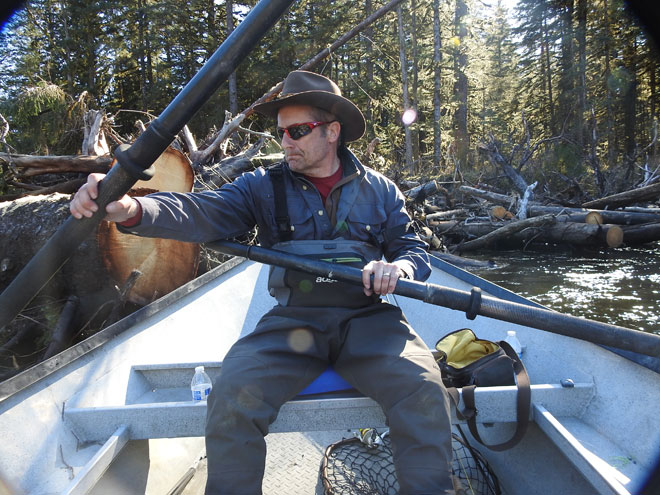
We took turns rowing through log jams and one time in a long, shallow rapid when I was on the sticks and Shannon was watching for rocks, we missed one, or rather, we didn’t miss it. I slammed into a small rock while the boat was turned and my brother-in-law took a header against the gunwale, breaking a tooth he had had repaired just four days earlier. The only consolation was now he could cut 10-pound mono with that tooth.
While bead fishing is one of the most popular techniques, yarn flies can be very effective. One favorite blends three strands of yarn – steelhead orange, light orange and white. Tie into a long egg loop knot then dunk it and wring it out and trim it up to a smooth round ball. The white yarn in the middle of the yarnie should make it appear to glow when seen against the evening sun.
COMPETITION FOR THE BITERS
Mid-morning one day in the middle of our trip, I stopped to look off the upstream side of the 14 Mile Bridge. At that moment, a large steelhead moved up from the pool below and found a place to hold in the riffle. Lesser fish darted to the sides while the fish, which I estimated at 28 pounds, assumed the best holding lie. Another large fish, well over 20 pounds followed it up out of the deep water.
I called my friend Gary Davis over to see the fish.
“Those might be the two biggest steelhead you will ever see,” I said. While we were there, both fish moved up into the next long run, headed upstream to spawn.
It might be the land of giants but a person should keep expectations in check. The Situk can be crowded in the spring. It’s better to look at the first trip to the Situk as exploratory or even as a pilgrimage.
Anglers in the know speak in hushed tones of 30-fish days, but the reality is it can be easy to have a zero-fish day. There are only two or three good access points and anglers jam into boats at the same time every day to compete for the same fish. Bank anglers fish up from the bridge and down from the bridge and the first mile upstream and downstream can be crowded.
On crowded rivers, steelheading is competition for the biters. In any pod of fish, I like to think that at least one is a biter. And research indicates that a lot of Situk fish are caught many times. There could be fresh fish in the river any day of the season and the first person on any stretch of water has the best shot at the biter.
This river, defined as it is by wood which can move around from day to day or week to week, changes so much that good holes come and go faster than any river I have ever seen. Still, there are known holes that hold fish 100 percent of the time and those places feel the most pressure.
In a constantly changing river, there are good holes people overlook simply because they are heading to a known or a favorite spot. Log jams can actually fence boaters out of good water.
Spot a place that can’t be fished from the boat? Pull over and get out!
When steelhead are in the river, people seem to forget about the Dolly Varden, but dollies can save a trip when the steelhead are scarce.
Dolly Varden are easily taken on beads and egg imitations when they match spawn in the river, and small swung streamers that resemble baitfish. When steelhead are in the best lies, dollies tend to bunch up in soft water adjacent to current seams.
Particularly when the water is low, anglers tend to pound the best steelhead water, ignoring the places where Dolly Varden seek refuge. By exploring long straight stretches of water, using polarized glasses and targeting schools of char, a fly-rodder can find great sport.
DO THE DIFFERENT THING
We tend to look for the same kind of water and we tend to fish the same way. Do the different thing to achieve different results.
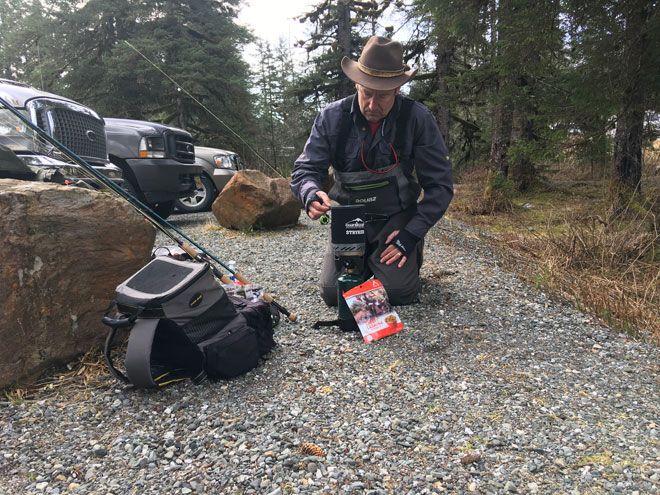
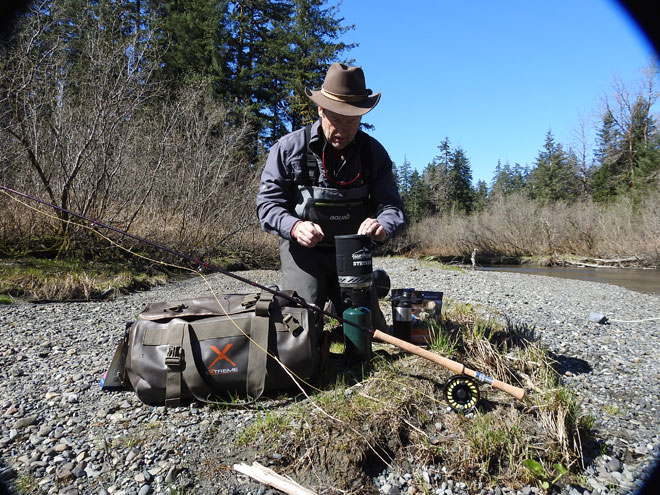
Most Situk anglers arrive from some other place and they do not bring tents and ground cloths and small camp stoves. They are not prepared to stay out overnight and hence, they start the drift at 8:30 in the morning and get off the river some 10 to 12 hours later. Boat after boat goes over the same fish. Five or six boats may go over a pod of fish in 15 minutes.
To break out of that cycle, plan to launch in early afternoon. Camp where the river makes a slow turn and steelhead stack like cordwood along a shelf. Fish that spot till dark, make a warm dinner, watch the embers burn down and the stars turn around the sky. Oh yeah, you probably won’t be able to see the stars because of the rain, but that’s okay. Rain puts you to sleep, as long as the tent isn’t leaking.
Also: The best gear for anglers camping in Alaska
On the second day, the flotilla starts again at daybreak, but you are already ahead of them. Stay on good water or fish down ahead and get to the launch early and race up to the launch again.
We might be in competition for the biters, but keep in mind Situk steelheaders depend on each other. Drift boaters depend on jet boaters to cut paths through the logs. The guides depend on other fishermen if something goes wrong in 14 miles of river. There is no road that follows the water.
The lodges depend on happy customers. In that spirit of sportsmanship, anglers share techniques in the few restaurants, down at the hardware store, over a coffee at Fat Grandma’s or between beers at the bar.
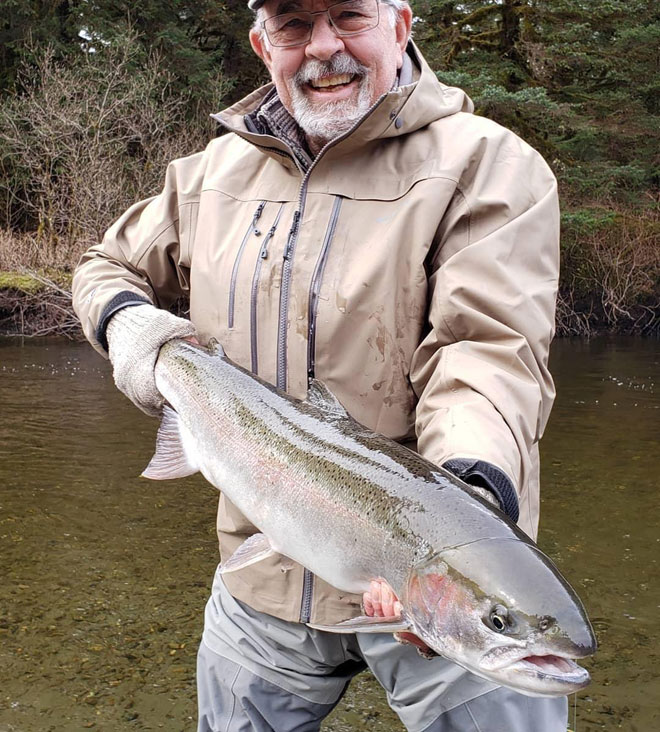
On our first day I hooked five steelhead with the river green and dropping. If we had been on the river the day before, I might have hooked ten. Closer to the weekend, and with the river low and clear, our hook-up ratios dropped considerably. It took real persistence and attention to detail to hook fish on the third day.
I suspect our best numbers were put up by the lone angler in our group who stuck with beads. That was 40-something Trey Sharp, and he never said how many fish he caught. My dad caught what may have been the biggest fish of the trip on the third day when the water was skinny. The rainbow-striped 13-pounder (as told by the length and girth formula) took a deep-running Wicked Lures spinner and battled back and forth across the river, thrashing at the surface, taking dad a considerable ways downstream before it was brought to hand.
Every one in our group caught steelhead, but the same could not be said for many of the fishermen gathered in the bar on our last evening.
Most anglers have a pretty good idea of what it takes to catch a steelhead on a bead, but there are intricacies and nuances. And quiet confidence and swagger for the fishermen who figure it out. They can catch big numbers of fish when the conditions are right.
When I should have been packing bags and stowing rods, I steeped in steelhead subculture in the bar at the Glacier Bear. Jake, a tugboat captain, and Dave, a nurse from Soldotna, had just come off the river after three chilly weeks in a wall tent. They were huddled with Ty Wyatt, a conservationist, guide and steelhead junkie who grew up in Lakeview, Oregon. None of us would have met each other except for steelhead. Mostly I listened, to stories of big fish, biology and steelhead beads.
“The bead has got to hunt,” Wyatt said. And I got it. Jake looked at me. He got it. Dave nodded.
Shaped by steelhead. Touched by the water. Haunted by the next fish.
To contact Gary Lewis, visit his website here.
This web-exclusive blog was originally posted on our site in April 2020.
The post Steelhead: Low and Clear on the Situk appeared first on Fish Alaska Magazine.
